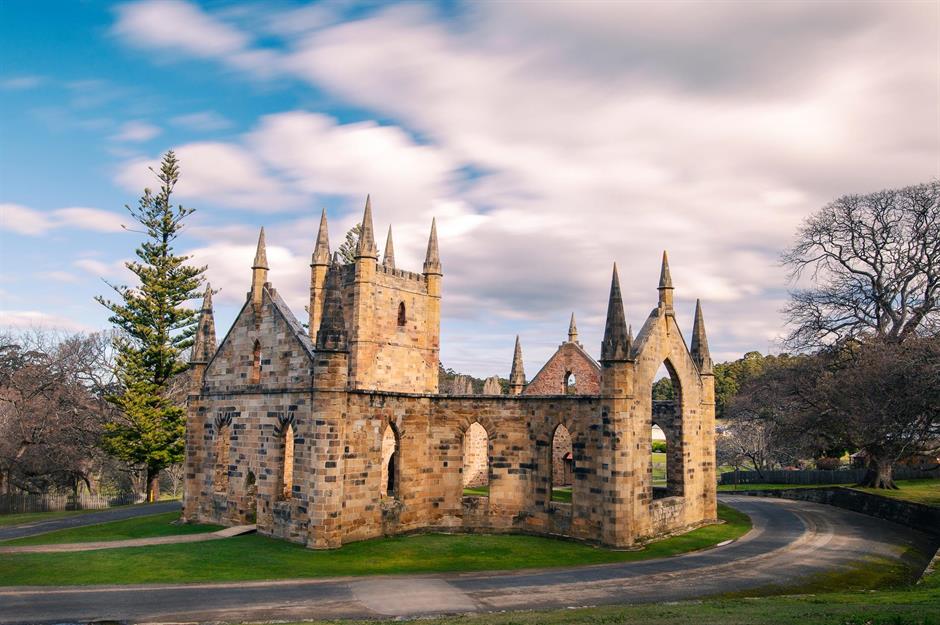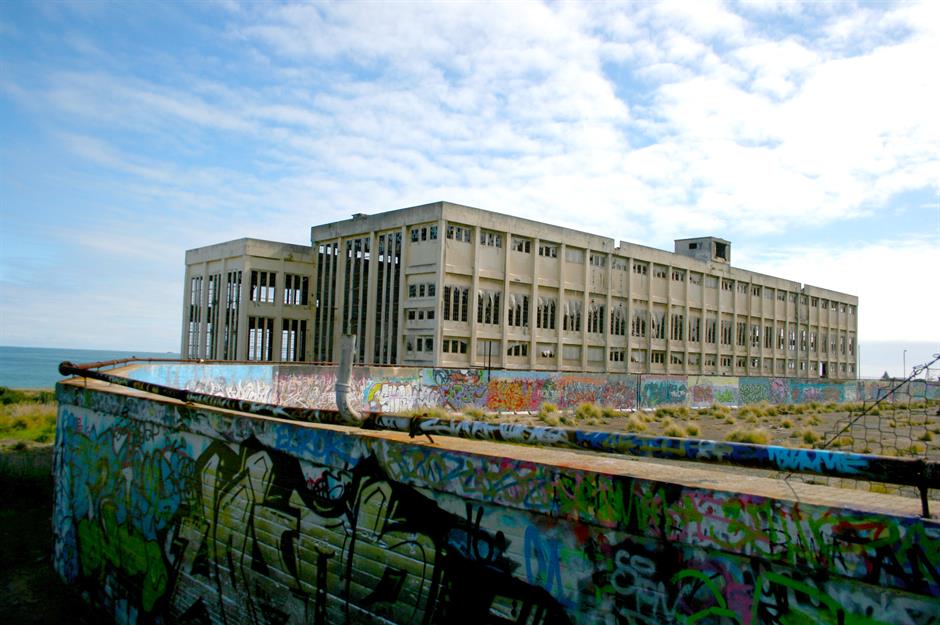Australia's eerie abandoned buildings
Stories behind the deserted places of Oz
From crumbling homesteads to forgotten hotels, Australia has abandoned buildings strewn from coast to coast. Here we peer through glassless windows and wander through moldering halls to bring you a virtual tour of abandoned Oz.
South Fremantle Power Station, North Coogee, Western Australia
South Fremantle Power Station, North Coogee, Western Australia
While the towering chimney stacks were demolished soon after, the rest of the plant has been left to the whims of Mother Nature. And, though it's supposed to be off limits, the hulking structure – with its glassless windows, graffiti-ridden walls and rubble-strewn floors – has become the domain of urban explorers. The building has been described as "ripe for redevelopment", but it remains in its current state for now.
Atlantis Marine Park, Two Rocks, Western Australia
A mammoth statue of King Neptune watches over the remnants of this abandoned water park near Perth. The park was built up in 1981 as part of an ambitious plan to draw more tourists to the area. Ultimately, its myriad pools and captive dolphin shows failed to make a splash and the park began leaking money. In 1990, Atlantis closed and was abandoned completely – today all that remains is a series of crumbling sculptures and graffitied buildings and, of course, the smiling God of the Sea himself.
Z Ward, Glenside, South Australia
This castle-like building, completed in 1885, was once used to incarcerate the so-called "criminally insane". The facility operated for almost 90 years, before being decommissioned in 1973. Afterwards, it was left to decay for several decades. Today, though, visitors can typically take guided tours of the eerie cells and deserted corridors with a Behind the Walls Tour or a Night Tour.
Grove Hill Hotel, Grove Hill, Northern Territory
Tarban Creek Asylum, Gladesville, New South Wales
Tarban Creek Asylum, Gladesville, New South Wales
Helensburgh Glow Worm Tunnel, Helensburgh, New South Wales
Mittagong Maltings, Mittagong, New South Wales
This vast malthouse complex, named for its location in Mittagong in the Southern Highlands, first opened in 1899 and operated right up to the 1980s. For many decades it was owned and used by Tooth and Co., a major New South Wales brewery, but a destructive fire and the eventual decline of Tooth and Co. itself meant the historic malthouse was finally abandoned. These are Australia's eeriest abandoned towns and villages.
Mittagong Maltings, Mittagong, New South Wales
Two main buildings still remain, albeit beaten by the weather and emblazoned with graffiti – and despite their deterioration over the decades, the creaking structures are still a striking sight. In recent years, the building has been sold and redevelopment plans are reported to include a 40-room hotel. The deserted malthouse had also been nominated for state heritage status.
SS Ayrfield, Wentworth Point, New South Wales
Once a working cargo ship, the SS Ayrfield is now trussed up in Homebush Bay, in a western Sydney suburb, and serves as a favored subject for traveling photographers. The bay is home to the wrecks of several abandoned freighters, which were decommissioned and left behind to molder. The SS Ayrfield in particular took on a new lease of life in its desertion – its hull is entirely swallowed by trees that have transformed the defunct ship into a floating forest. Discover more of the world's stunning shipwrecks here.
Wallace's Hut, Bogong High Plains, Victoria
Paronella Park, Queensland
Paronella Park was the brainchild of Spanish-born José Paronella, who snapped up a small plot of land by Mena Creek Falls. His lush site eventually consisted of a concrete castle, plus a swimming pool and some 7,000 trees. José sadly passed away in the 1940s and by the 1970s, the park had been sold outside the family. A devastating fire, as well as several cyclones, also ripped through the castle, leaving it in a decrepit state. Now, though, preservation work has been carried out by the current owners and tourists typically come to marvel at the castle's shell and wander the leafy grounds.
Victoria Settlement, Port Essington, Cobourg Peninsula, Northern Territory
This series of ruins on the Cobourg Peninsula represent a failed attempt by the British to settle Australia's northern coast. The fated settlement, now part of Garig Gunak Barlu National Park, was named Victoria. It was established in 1838 but the settlement's remote location, not to mention its festering diseases, meant life was a struggle. Take a look at Australia's most beautiful national parks here.
Victoria Settlement, Port Essington, Cobourg Peninsula, Northern Territory
By 1849, the settlement, which included a church, a hospital and houses, had been branded a failure and was dissolved. Today a remote knot of crumbling ruins remain amid the overgrowth. Visitors to Garig Gunak Barlu National Park can take a boat ride to explore them (a permit is needed to access the park).
Beechworth Asylum, Beechworth, Victoria
The Italianate-style Beechworth Asylum, also known as Mayday Hills, dates to the 1860s and was in operation for 128 years. More than 1,000 patients lived here during the asylum's peak, making it one of the largest hospitals of its kind in Victoria state. According to preserved diaries and reports, cruel treatments and restraints such as straight jackets were once used and the facility was decommissioned in 1995. Now the haunting site offers history, ghost and photography tours.
Royal Hotel, Linda, Tasmania
Set of All The Rivers Run, Blackwood, Victoria
All The Rivers Run was a TV mini-series adapted from Nancy Cato's 1950s novel of the same name. The series hit screens in the 1980s and followed an orphaned young protagonist who finds herself shipwrecked off the Victoria coast. It was filmed in Victoria itself, not far from Wombat State Park in Blackwood, and a creaking wooden saloon and bank still remain from the abandoned set. Check out more abandoned movie sets from around the world.
Doc Holiday's Cafe, Wittenoom, Western Australia
Darlington Probation Station, Maria Island, Tasmania
This former convict settlement and convict probation station sits on Tasmania's windswept Maria Island, and operated from 1825 to 1850. Over the decades, the site was home to hundreds of convicts, forced to labor here under severe conditions. Today the settlement is a UNESCO World Heritage site and visitors still come for a dose of history and to drink in the 13 preserved buildings from the era.
Aradale Asylum, Ararat, Victoria
Aradale Asylum, Ararat, Victoria
Now curious visitors can usually wander through the abandoned institution on a guided tour, peeking inside wasting wards and traipsing through echoing corridors. Tours are temporarily suspended due to COVID-19, but keep an eye on the website for updates.
Transcontinental Hotel, Farina, South Australia
The burnt-orange ruins of the Transcontinental Hotel dominate Farina, a ghost town that declined through the 20th century. They stand, together with a smattering of other wasting buildings, as an emblem of this former railhead and farming town, which was left abandoned due to parched conditions and a rerouted railway track. The hotel, which also served as a hospital and boarding house over the years, has battled the elements to remain the town's most striking attraction. Discover more abandoned hotels around the world.
Boggo Road Gaol, Brisbane, Queensland
Boggo Road Gaol, Brisbane, Queensland
Now guided tours explore the abandoned gaol each week. The History Tour tells stories of the prisoners' day-to-day lives and the infamous rooftop protests here, while the Escape Tour has a special focus on the facility's many jail-breakers. Most insightful of all is the Prisoner Tour which is led by a former inmate. Tours are currently operating at reduced capacity with COVID-secure measures in place and booking is essential.
Burra Homestead, Burra, South Australia
This abandoned homestead in South Australia might not look like much but fans of Australian rock band Midnight Oil will be well familiar with its image. Captured by lauded landscape photographer Ken Duncan, a picture of this humble homestead graced the cover of the band's 1987 album Diesel and Dust. Today it remains in its solitary state, a symbol of both the stark Australian outback and a group of rock legends. Check out Australia's most stunning natural wonders.
Castle Fun Park, Mandurah, Western Australia
A stone's throw from the coastal city of Mandurah lies Castle Fun Park, a wholesome family amusement park that was completed in 1979. The family-friendly site would attract travelers en route to Perth with its fairy-tale European-style castle, playground and swimming pool in the shape of Australia. Sadly, though, the stream of visitors began to dry up and the park closed in the early 2000s. A bushfire ravaged the site's remnants so now all that still stands is the turreted castle surrounded by trees and covered in graffiti.
Port Arthur, Tasman Peninsula, Tasmania
Port Arthur, Tasman Peninsula, Tasmania
The prison complex was eventually closed in 1877, but visitors can still learn more about the site's somber history here. Around 30 buildings dot the site, from the convict-built church to an eerie graveyard – some structures are well-preserved, others are mere ruined shells of their former selves. Ghosts tours are also available, where guides regale tales of spirits and specters by the light of a lantern.
Love this? Now discover abandoned subway stations from around the world

